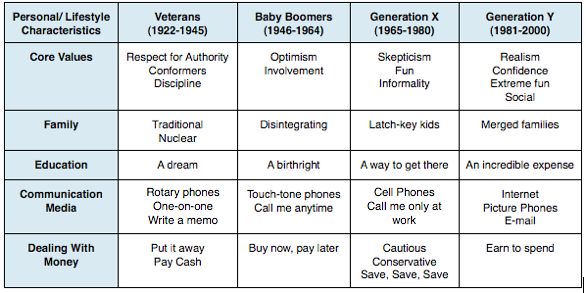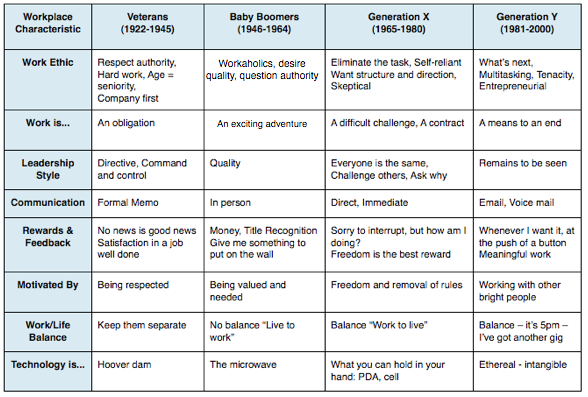Four Generations: Can't we all get along?
Danielle Peterson - September 2011
Ready for yet another form of diversity? Notice the ages of the people working around you. Notice how young the new college grad is sitting next to the just about ready to retire manager in your meeting. Notice the senior citizen bagging groceries, the college student cashier and the middle-age manager at your local market. Actually, there's never been a time in United States history that we've experienced such age diversity in the workforce.
Managing and motivating diverse workers has been a leadership topic for at least 20 years with gender and culture being at the center of the conversation. Now, as our youngest generation takes their place in the working world at the same time some of our older generations are re-entering, we are experiencing an unprecedented four generations working together! Many managers are learning that a one size fits all management style is not going to work across generations. Effectively leading in a multi-generational workplace begins with understanding the basic demographics and characteristics of the generations around you. The four generations each bring different viewpoints and are guided by values deeply rooted in their unique experiences.
Four Generations Currently at Work in The United States

Realize that each of these four generations grew up experiencing significantly different events, events that have shaped their values and their perception of work. For example, the Veterans survived World War II and grew up with a strict regimen, making quality, respect and authority important to them. Baby Boomers embraced the value of having to sacrifice to get ahead. All that sacrifice makes them very loyal. Generation X are the latchkey children who watched their Boomer parents forge a new workplace. In turn, Gen X made their work more efficient and effective with advances in computing technology, making them care more about productivity and less about the number of hours spent on the job. Millennials, having grown up in the internet, mobile computing and social media age are uniquely comfortable leveraging these technologies in their everyday life, giving them a propensity for multi-tasking and leaving them easily bored.
To really understand the generations it's helpful to consider their underlying values, or personal and lifestyle characteristics as shown in the following table.

Given these underlying generational values makes it easier to understand these resulting workplace characteristics attributed to each generation (see Workplace Characteristics chart below).

The characteristics listed in the tables are a very few of those that have been studied and reported by various authors. Not every person in a generation will share all of the various characteristics shown in this or the next table with others in the same generation. However, these examples are indicative of general patterns in the relationships between and among family members, friends and people in the workplace. Individuals born at one end of the date range or the other may see overlapping characteristics with the preceding or succeeding generation.
Generational Strengths
Understanding the generations at work around us can help increase tolerance for their important differences in values and perspective. Equipping your team with this knowledge can help bring focus to each generation's strengths. Based on research done by Ron Zemke, author of the book Generations at Work, the majority of conflicts arise from the value differences of the age groups rather than the actual age difference itself. So it's more about "my values are the right ones and yours are not." For example, Veterans may think the "young kids" in the workplace are lazy, while the Millennials or Gen X'ers may think the Veterans and even Baby Boomers are too rigid. However, if all of us are open-minded and consider the events that shaped each generation, we can learn to appreciate and learn from our co-workers from different generations.
Each generation brings wonderful strengths to the workplace and helping generationally diverse work groups understand and leverage these strengths in their co-workers can lead to less conflict and more productivity. Publicly acknowledge what each generation's strengths are and encourage everyone to share their viewpoints and values with the group. Get the conversation started by being curious about the viewpoints of co-workers from a different generation. Your questions will demonstrate your genuine interest in them personally and in their generation. Your interest in another's generation demonstrates that you are willing to bridge your generational differences rather than rely on your own perceptions or worse yet, the prevailing stereotypes. This kind of demeanor is catchy.
Adapt Your Management Style: Acknowledge Bias
Leading four different generations often requires adjustments in management style for each generation. For example, a Baby Boomer manager managing a Millennial employee may question their commitment when the younger worker ends their day at 5pm every day. Even if the Millennial's work is getting done, the Baby Boomer, valuing loyalty, may question the commitment of someone who doesn't put in more hours, feeling they are "just doing enough to get by." In turn, the Millennial probably does not think how long he stays at work has anything to do with his commitment to his job or the company. The real problem is the Baby Boomer's belief that long hours represent commitment versus the Millennial belief that staying late at work for no reason demonstrates nothing but an out-of-balance life. The point is that we must be aware of our own generational biases and when managing across generations, be careful to consider the generational values before judging or rewarding work-place behavior.
Adapt Your Management Style: Find Options to Motivate
No matter how hard we try, we are not going to change generational differences, which are based on life experiences and run deep within those at work around us. Instead, we must acknowledge the differing values and adjust how we motivate people in each generation. Incorporate different motivational techniques into your management practice. Recognize that those in each generation may be motivated differently, and what a Baby Boomer sees as an incentive may not appeal to a Millennial. For example, a Gen X'er may want time off for a job well done, while a Veteran may want a monetary bonus. Consider your employees generation when attempting to motivate or provide incentives. Give people choices. After all, if someone really values family and wants time off to spend with his or her loved ones, all the money in the world won't make that person happy. Rather, he or she will seek out a company that offers ample time off, even if it means accepting a lower salary.
A Successful Workplace...for Generations to Come
The workplace is challenging enough without letting generational differences complicate it further. By identifying the four generations, acknowledging their values, and adapting a management style for a generationally diverse workplace, we can more effectively draw on all the strengths of our team. And in a marketplace where only the strong survive, we need all our team members, young and old, focused on the same objectives and working together effectively.
For further reading:
- Generations at Work: Managing the Clash of Veterans, Boomers, Xers, and Nexters in Your Workplace, by Ron Zemke, Claire Raines, and Bob Filipczak.
- When Generations Collide: Who They Are, Why They Clash, How to Solve the Generational Puzzle at Work, by Lynne Lancaster
Source:
Zemke, Ron; Raines, Claire; Filipczak, Bob. Generations at Work: Managing the Clash of Veterans, Boomers, Xers, and Nexters in Your Workplace. New York, N.Y.: American Management Association, 2000.
Join the conversation
Add your experience to the conversation on LinkedIn or Facebook.


